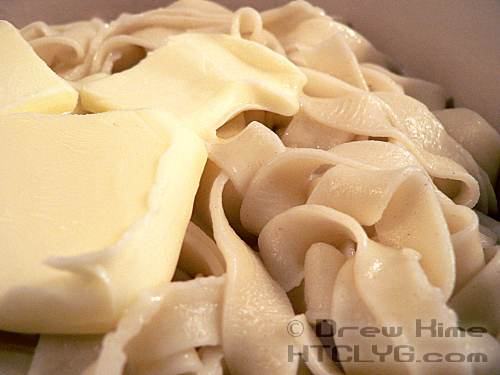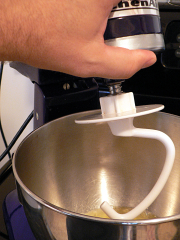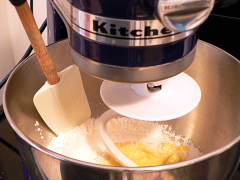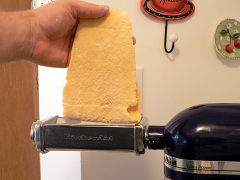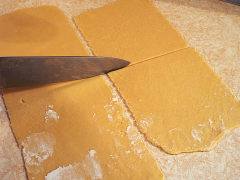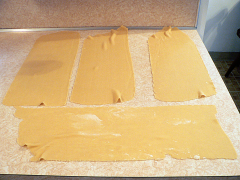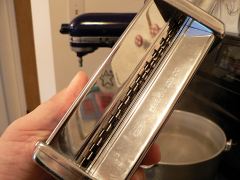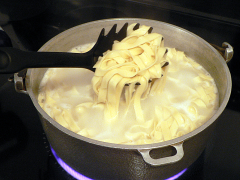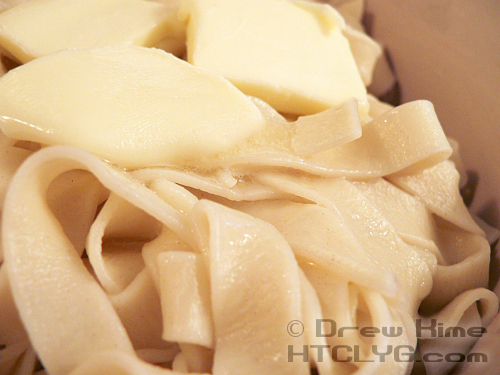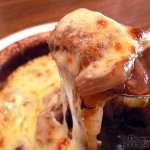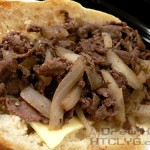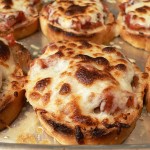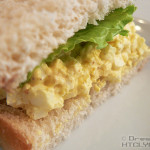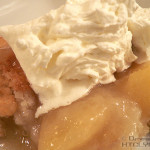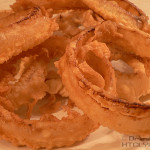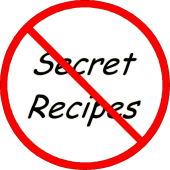I’m jealous of my kids. For one thing, they’re cuter than I ever was so life will be easier for them. But that’s not what I meant. What I was getting at is that they get home-made egg noodles. Man, these things are good.
Ingredients

1-1/2 cups flour
2 large eggs
2 teaspoons kosher salt
(I really need to fix the label on that flour canister. That looks totally unprofessional.)
Directions
The last time I made pasta I did it the old fashioned way: Make a pile on the counter with a well in the middle, crack the eggs into the well, combine with a fork until well mixed, then knead.
I decided to try the high-tech way this time. Power tools. Whee!
So add the flour — only one cup to start — salt and eggs to the mixing bowl of the trusty Kitchenaid. (This is not a paid endorsement. That’s just what brand of mixer I’ve got.)
And start mixing on low speed using the dough hook.
The egg is going to want to stick to the hook, so you’ll have to scrape the sides a couple of times to get all the flour incorporated.
Once everything is well mixed, if the dough is still stretchy and sticky it needs more flour.
It’s ready once the dough forms a ball. The mixer can’t finish the kneading, so you’ll have to take it out and do some by hand.
This clip is a little long, but shows how you keep folding the ends in and rolling with the heel of your hand. If I did this for a living I could probably do it with one hand. Since my day job is behind a desk, I need both hands. This is hard work. You’ll see at the end of the clip that I’m done kneading when all the flour is evenly incorporated, and the dough is pliable but not sticky.
Divide the dough in half. All the steps coming up you’re going to have to do for each piece.
Roll the piece of dough in flour and tap off the excess. This is just to keep it from sticking to the roller on the first pass.
Put the dough through the pasta roller on the widest setting.
The process is the same if you have a hand-cranked roller. You’ll just work harder doing it. If you don’t have a roller, you can do this by hand. I’ve seen it done. There’s no way I’m working that hard for noodles.
Fold the dough in half and pass it back through, still on the widest setting.
If you look close in that last photo (click it for a larger view) you can see that it wasn’t smooth and even like it should be. Keep folding in half and running through until it comes out smooth and even.
Once it’s smooth, turn the roller to the next narrower setting and run it through again. Don’t fold it in half any more. You’ll be surprised the first time you do it how much longer the dough gets each time you close down the roller.
I’ve seen people with hand-cranked rollers work sheets of pasta that were several feet long. They cranked the dough back and forth through the roller, which was mounted in the middle of a long table.
Since I’m using a power roller that only goes in one direction — and that direction is “down” — I have to cut the pieces in half once they start getting too long.
I like my egg noodles slightly thick, so I went to 5 out of 8 on my roller. When I’m making noodles for soup I’ve gone as thick as a 3. For angel hair you’d go to 8. Even at 5 you need to be careful to feed the sheets in straight. It’s really stretchy, and it’s easy to get the edges folded over.
Once again I take the easy way out with the roller-slicer. Click the picture to see the larger version, where you can really make out the sets of cutting wheels.
Feed the pasta through the same way as with the roller. Be ready to catch odd pieces as they fall out the bottom. If you’re not absolutely perfect feeding it in you’ll get some short pieces on the edges.
You’ll see in this clip that I go straight from the cutter to the boiling water. I’ve tried hanging pasta to dry, but it takes up a ton of space. I’d rather make what I need when I need it.
I’ve got one of these cutters for angel hair, too. You need to make the dough a bit drier and firmer, or it will stick in the tiny rollers. I find the wide roller to be much easier to work with. Besides, I’m not a huge fan of angel hair.
If you could see the timestamp on that video clip, you’d see that it’s only four minutes until this next shot where the pasta is done.
Fresh pasta cooks much faster than dried, since it doesn’t have to rehydrate. So the first time you do it, don’t count on your regular cooking time. Start checking as soon as it starts to float.
Add plenty of butter.
And let it melt.
And that’s it.
Tomorrow I’ll have something great to put on top of the noodles. It was a request from Kim in Alaska.
